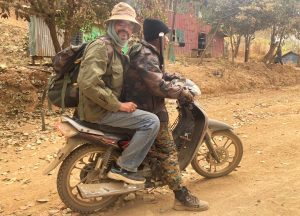Reporting from Myanmar has always been challenging, even a dangerous endeavor. For decades, Myanmar under military rule was hard for journalists to access. When the country was under quasi-civilian governments (2011-2021), democratic reforms were initiated, including the restoration of the freedom of the press. This facilitated reporting from regions that had been reeling under instability and unrest for decades.
Then on February 1, 2021, Myanmar’s military staged a coup. Leaders of the elected National League for Democracy government were arrested and pro-democracy activists were detained. A massive crackdown on the media followed. It became hazardous again for local and foreign journalists to report from the country.
It was in these circumstances that I decided to visit Myanmar. My objective was to report on the resistance to junta rule. Since the chances of reaching a rebel camp from Yangon through regular routes and legitimate channels, and returning home unscathed from the assignment, were near impossible, I decided to sneak into the country through the India-Myanmar border.
Between April and May of last year, I met some leaders and functionaries of the resistance groups at various points along the India-Myanmar border in the Indian states of Mizoram and Manipur. The success of my visit, I realized hinged on establishing contacts ahead and in availing the services of a translator. During the planning phase, I zeroed in on five places in Chin State and Sagaing Region to visit: Tamu, Kalay, Haimual, Camp Victoria, and Thantlang. Kalay was the farthest from the border with India while Tamu was the nearest.
I reached the border town of Zokhawthar in Mizoram on January 11. Here is an account of some of the unforgettable incidents during my three-week journey in Myanmar.
The Ukraine Effect—Trucks Smuggling Wheat Flour From India
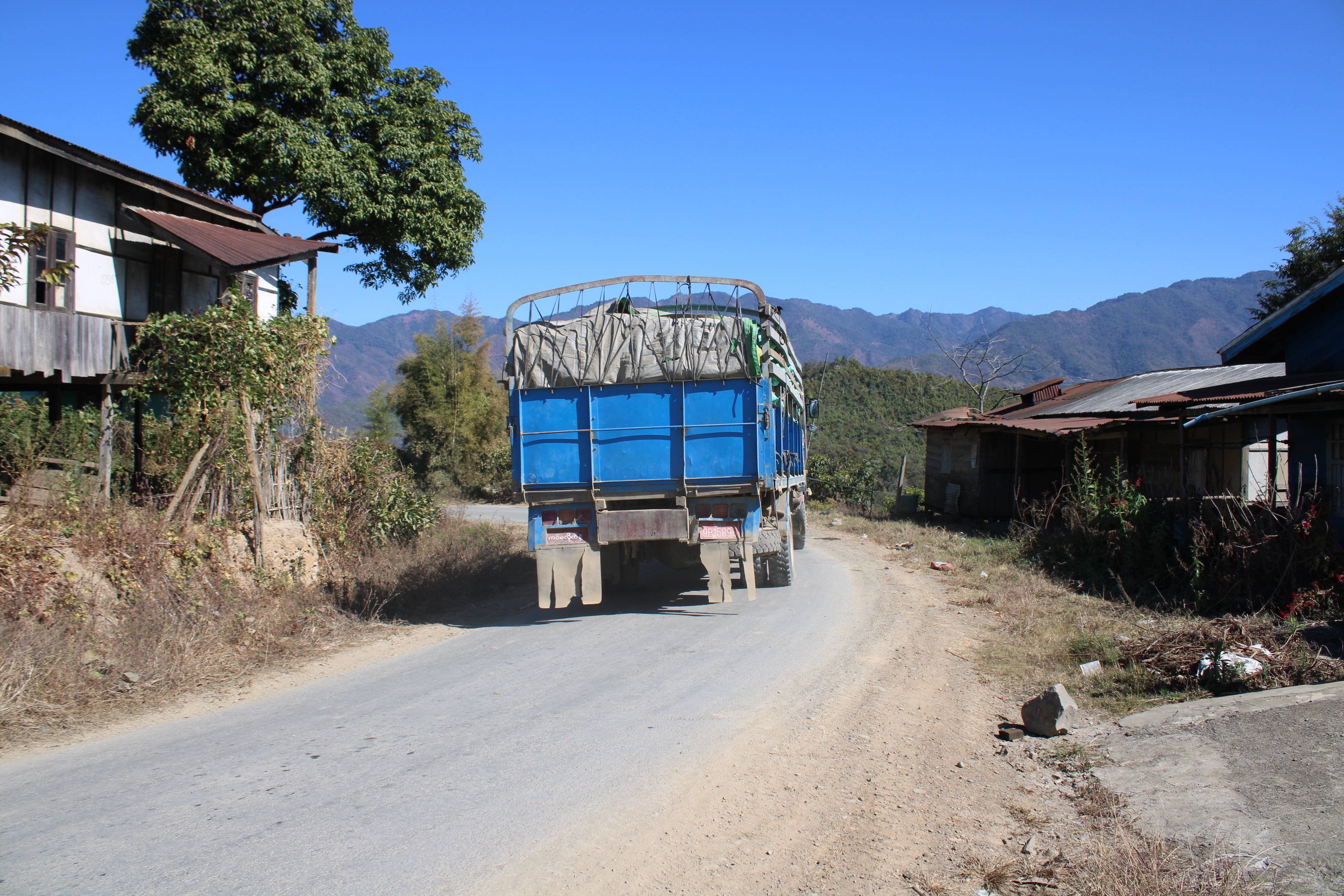
A truck heading to Kalay from the bank of Tiau river in Myanmar’s Chin State. Photo by Rajeev Bhattacharyya.
The first incident that shook me happened less than half an hour after we began our journey from Zokhawthar in Mizoram on motorbikes. The road to Kalay was dusty and potholed, with just a few stretches of concrete. A truck came at us from the opposite direction; it was traveling at normal speed but was dangerously close. It could have hit us, with fatal consequences. The person driving my motorbike, a young functionary of a People’s Defense Force (PDF), was able to veer away from the truck in the nick of time to avert a collision.
I knew the trucks, which were coming from the banks of the Tiau river, were carrying smuggled items from India to Myanmar. But what my companion told me later about the consignment in the truck came as a surprise. “Most of these trucks are carrying wheat flour to China. The conflict in Ukraine has created a great wheat shortage in China and hence, the smuggling of the item from India,” he said. “These trucks will offload the consignments somewhere near Kalay from where they will be transported to another destination in different vehicles.”
His claims were later confirmed by a government official in Mizoram, who pointed out that wheat flour is sourced from different places, including Silchar in southern Assam.
Flour is a new item in the long list of commodities that are illicitly traded between India and Myanmar. What’s traded along the 1,020-mile-long border varies. While medicines, clothes, and food are commonly traded along the entire stretch, narcotics such as heroin and Yaba, as well as betel nuts are ferried through multiple routes in Manipur and Mizoram. Exotic animals from Southeast Asia have begun to figure in the list in the past three years.
The Humming Sound of Planes At Night
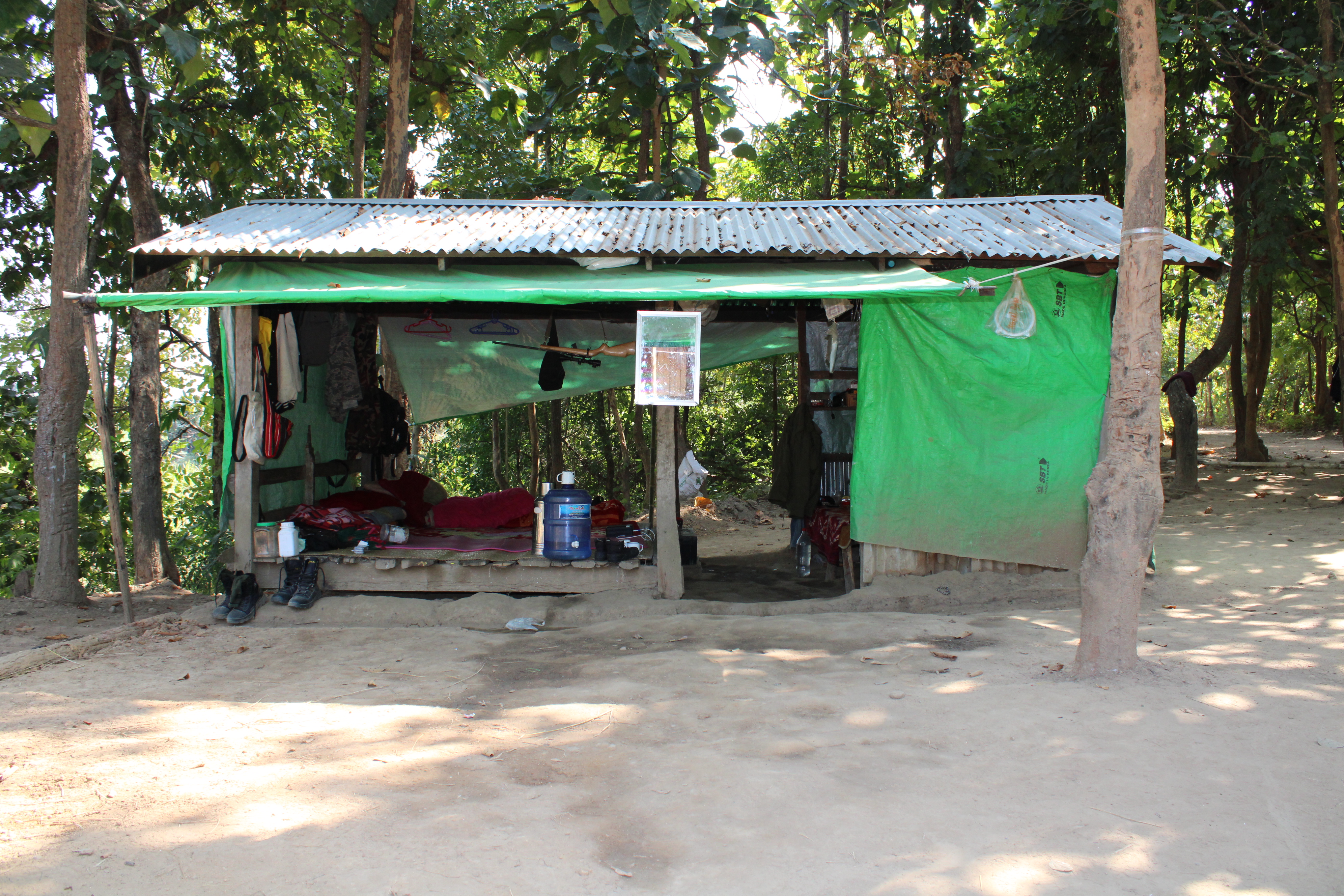
The shelter at the camp of Chin Rifles at Kalay in Myanmar’s Sagaing Region where the author stayed. Photo by Rajeev Bhattacharyya.
I crossed the border to Kalay in the company of five resistance fighters. We were on three motorbikes. It was supposed to have been a journey of eight hours but turned out to be three hours longer because of the bumpy and meandering hill roads. We also had to stop at some places to ensure that the road was free of the military’s presence. We did not see the military anywhere en route, except a small military establishment spotted on Kennedy Peak about 10 miles after crossing Tedim.
We reached our destination, a camp of the Chin Rifles deep in the jungles in north Kalay, at 10 p.m. After dinner, I dozed off within minutes on a bed of timber and bamboo. At 2 a.m., I suddenly woke up. The sound of airplanes high in the sky startled me as I did not expect them to be flying here. Was it a junta fighter aircraft on a mission to bomb the rebel camps? This was possible as the junta has its network of informers that provide it with location details of rebel camps in this region.
I leapt out of bed and rushed out of the shelter I was staying in to stare at the sky for a few minutes. All that was visible were stars in a clear winter night and a falling star as well, which I assumed to be a satellite for a moment. The humming sound died away, only to be heard again after an hour. I was anxious and could not sleep again.
The next morning, I met a senior functionary of the Chin Rifles. I recounted the events of the night. He calmed my nerves by telling me that the route of some transnational flights passed over Kalay. I heaved a sigh of tremendous relief.
COVID-19 Saves Many Families
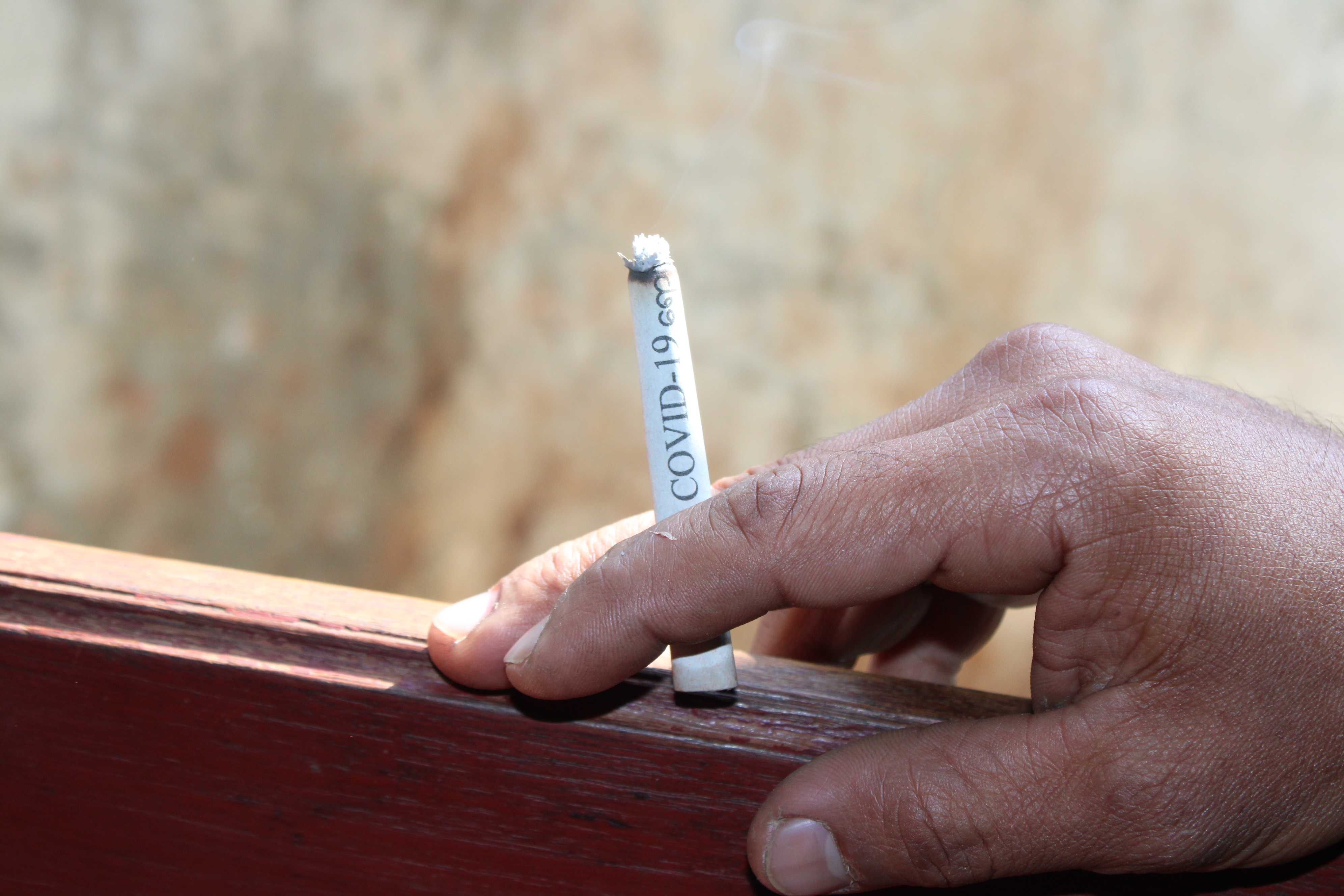
The “COVID-19” cigarette that is locally manufactured in Kalay. Photo by Rajeev Bhattacharyya.
It was clear that the humanitarian crisis was worsening in Kalay as it was in other parts of Myanmar. Roads and markets were almost deserted by noon. Little agricultural activity is happening. Only once did I see four people, including a woman, gathering vegetables from an agricultural field in Letpanchaung. Prices of many essential commodities are soaring, compelling families to slash their monthly budgets and reduce their consumption of food.
One day I noticed something unusual at the residence of a resistance fighter near Kalaymyo city. An elderly person was smoking a local hand-made cigarette. It was emitting an extremely pungent smell. I wished to get a taste of the cigarette and asked him for one. The name of the cigarette was “COVID -19.” My curiosity deepened further. The urge to take a few drags got the better of me. I did. And then I blacked out after a minute or so. I sat down and snuffed out the cigarette.
But why the name COVID-19? I asked the elderly person. “The story goes back two years when this region was severely hit by the pandemic,” he said. “This cigarette is preferred over other brands by a large number of smokers in and around the city. Not a single person in this area, who smoked this cigarette was afflicted by COVID-19,” he claimed.
Apparently, when the pandemic receded, the manufacturer of the cigarette decided to name it COVID-19, which is meant “to convey the message that the virus was burned by this cigarette,” said a man accompanying the elderly person. He added that he knew at least three families, including the manufacturer and distributor, who were doing well economically from the sales of the cigarette amid the economic downturn and inflation in the country.
Videographing a Military Camp

A video grab of a military establishment in Kalay that the author crossed on his way to a local manufacturing unit. By Rajeev Bhattacharyya.
Among the challenges I faced at Kalay was to gain access to local weapons manufacturing units. Rebel functionaries of two units agreed to show me how guns are produced on the condition that I would not disclose their location. The first was in a village around 25 miles from the place where I stayed in north Kalay. But the route to the unit ran along a medium-sized military establishment that we would have to cross. There was no alternate track to reach the village.
“Sir, are you willing to visit the unit? There is no check post on the road anywhere near the military center. Rarely do the soldiers check vehicles on that route. And if they do, we will be able to know from a distance and we can turn back,” a PDF functionary tasked to take me to the weapons manufacturing unit told me. But there was a hitch. “There is a danger that they might shoot at fleeing motorbikes,” he said, adding that this had happened on some occasions in the past.
I replied in the affirmative, since getting access to other units was difficult. The PDF functionary suggested that I should appear “very normal” and look straight at the road ahead while crossing the military unit. He asked me to remove the full-face woolen cap I had been wearing since arriving in Myanmar. Instead, he suggested I wear the type of face mask commonly worn during the pandemic.
On January 21, around half-an-hour after we had set off on our journey, the military center came into view on the left side of the road. It was a spacious establishment, full of greenery and medium-sized barracks, but I could not see a single soldier there. When I asked my biker companion, he replied, “There are two of them amid the sandbags on the side of the gate which you will notice and there are more that remain camouflaged inside.” I could see a rifle barrel, perhaps a light machine gun (LMG), placed on top of sandbags but saw no military personnel. We crossed the center safely at break-neck speed.
After completing the assignment at the weapons manufacturing unit, I asked the PDF functionary if it would be possible to click a photograph of the military establishment from my cell phone.
“The best would be a video. When I give the green signal, press the video button on the cell phone, which must be kept at the level of the waist in a casual manner,” he suggested. I did and managed to capture a short video of the establishment.
The Church in Thantlang
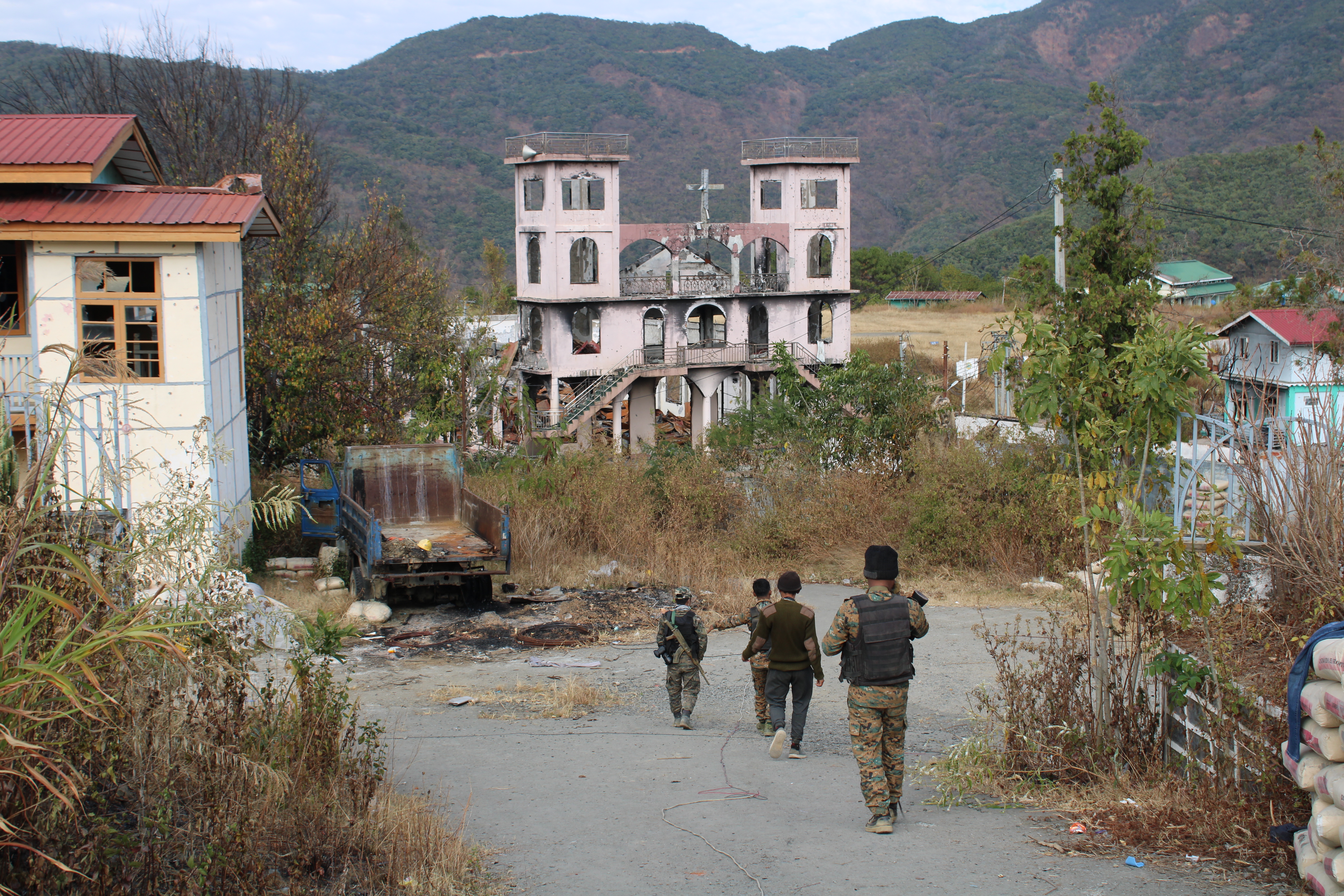
The church in Thantlang in Myanmar’s Chin State, which was bombed several times by the military. Photo by Rajeev Bhattacharyya.
Thantlang is a ghost town in ruins in Myanmar’s Chin State. I was relieved when Dr. Sui Khar, vice chairman of the Chin National Front (CNF), permitted me to visit the town but on the condition that I should not stay there for more than an hour. A team of three CNF functionaries headed by a middle-rung officer of the Chin National Army (CNA), the armed wing of CNF, was assigned the task of taking me to visit the abandoned town, an internally displaced persons camp, and the camp of another rebel group, the Chinland Defense Force (CDF) Thantlang.
After I had taken photographs and videos in Thantlang, a commander of the CNA instructed me to sit at a safe spot near a church totally destroyed by bombings. Before doing that, I decided to climb the stairs of the church that led to the terrace facing the road and the eastern flank of the town that had a hillock where the military had its camp. It was about 300 meters from the church. My objective was to click a few photographs from a higher elevation that would provide a broader view of the town.
When I reached the terrace, a CNA functionary yelled at the top of his voice, “Sir, please come down immediately. There are snipers in the military establishment with their rifles pointed at the church.” He told me that one of his colleagues had a narrow escape three months ago. I sat down instantly and descended the stairs at a furious pace to avoid getting shot at.
I had a similar experience when I entered a school near the church. When I reached the gate, a functionary roared at the top of his voice forbidding me to step inside. The rebel squad believed that the military personnel had planted landmines in the school premises before being compelled to retreat to the camp in the hillock. At two places, bamboo spikes were erected by the military to halt the rebels’ progress in occupying more areas in the town.
Tamu – Where Danger Lurks at Every Corner
The view of Tamu from the Indian side in Moreh is deceptive. It is a wide expanse of land with a couple of beautiful pagodas, conveying an impression of peace and prosperity in the region. However, visiting Tamu to understand the resistance movement turned out to be the toughest among all the places that I visited. Skirmishes and bombings have been frequent here and only about 10–15 percent of this border district was under the control of resistance groups as of March this year.
There are eight PDFs active in Tamu with their members belonging to the Bamar, Chin, Kuki, and Gorkha communities. Senior functionaries of the Kachin Independence Army (KIA) are also present in the region to supervise the operations and coordinate with other groups in Sagaing Region. Full control over Tamu is vital for the junta as the border town is linked to major towns and cities in Sagaing Region and Mandalay. In addition, Tamu is a source of extra income for the military personnel since it is a hub of smuggling activities.
My plans to visit the PDF camps here were cancelled twice, once in mid-November of last year and again early in March this year, when the military used helicopter gunships to attack resistance camps, killing at least three functionaries. The camps were relocated frequently to avoid further attacks by the military. Finally, on March 24, I was called to a place not very far from the border, where parliamentarian Thang Sei and some resistance fighters agreed to be interviewed with their photographs, which was accomplished successfully.
My request for an overnight stay was rejected by the PDF functionaries as they were apprehensive over the situation in Tamu. There is a threat in the area not only from the military but also from the junta-aligned local militias known as the Pyu Saw Htee. Landmines had been planted along some routes between Moreh and Tamu. A week later, after I had returned to Imphal, there was an encounter reportedly between the PDF and Pyu Saw Htee at a spot near to where I was given the interviews.
Every covert assignment in a conflict zone throws up surprises, unpredictable situations and unexpected results. The Spring Revolution in Myanmar is multilayered, nuanced, and complex with every region displaying its own characteristics. The information gathered in 21 days offered ample food for thought and the scope to draw conclusions on the situations in Chin State and Sagaing Region.
It is difficult to predict when or how the war would end. But what appears certain is the new path that the Myanmar people have embarked upon. Myanmar will never be the same again.













